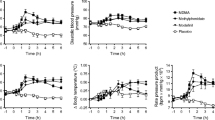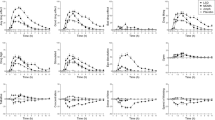Abstract
A variety of studies withhabitual users of nicotine, caffeine, cocaine, and amphetamines have shown that administration of these stimulants has the paradoxical effect of lowering arousal states. Research on transmarginal inhibition shows that when subjects are presented with a succession of stimuli monotonically increasing in intensity, GSR and related arousal responses increase first and then begin to decline beyond a certain point of stimulus intensity. That is, following repeated exposure to intense stimuli, continued more intense stimulation has the effect of lowering arousal. Since stimulants subjectively heighten stimulus intensity, the transmarginal inhibition data provide a basis for explaining opposing effects of stimulants on arousal, depending on dose and frequency of use. It was hypothesized that when dose levels are low and usage is infrequent, arousal increases with stimulant intake. In contrast, when dose levels are high and frequent, arousal shows decrements with new intakes of stimulant. A new questionnaire measure of characteristic arousal was developed and correlated with subjects' reports of habitual levels of stimulant and sedative intake. Weekly total stimulant use correlated significantly and negatively with characteristic arousal level, providing support for the hypothesis. This lowered arousal of frequent stimulant users was not a confound of, or due to, concomitant frequent sedative use, since total stimulant and sedative use levels were uncorrelated.
Similar content being viewed by others
References
Agué, C. (1973). Nicotine and smoking: Effects upon subjective changes in mood.Psychopharmacologia (Berl.), 30 323–328.
Armitage, A. K., Hall, G. H., & Sellers, C. M. (1969). Effects of nicotine on electrocortical activity and acetylcholine release from the cat cerebral cortex.British Journal of Pharmacology, 35 157–160.
Ashton, H., Millman, J. E., Rawlins, M. D., Telford, R., & Thompson, J. W. (1976). The use of event-related slow potentials of the brain in the analysis of effects of cigarette smoking and nicotine in humans.Abstracts, International Workshop on the Behavioral Effects of Nicotine, Zurich.
Bajerot, N. A. (1970).Addiction and society. Springfiled, Illinois: Charles C. Thomas.
Bradley, C. (1937). The behavior of children receiving benzedrine.American Journal of Psychiatry, 94 577–585.
Cherek, D. R. (1981). Effects of smoking different doses of nicotine on human aggressive behavior.Psychopharmacology, 75 339–345.
Cohen, S. (1970). The hallucinogens. In W. G. Clark & J. del Giudice (Eds.),Principles of psychopharmacology (pp. 489–503). New York: Academic Press.
Eysenck, H. J. (1973). Personality and the maintenance of the smoking habit. In W. L. Dunn (Ed.),Smoking behavior: Motives and incentives (pp. 113–146). Washington, D.C.: V. H. Winston.
Eysenck, H. J. (1980).The causes and effects of smoking. London: Maurice Temple Smith.
Gilbert, D. G. (1979). Paradoxical tranquilizing and emotion-reducing effects of nicotine.Psychological Bulletin, 86 643–661.
Grinspoon, L., & Hedblom, P. (1975).The speed culture: Amphetamine use in America. Cambridge, Massachusetts: Harvard University Press.
Gutiérrez-Noriega, C. (1949). Inhibicion del sistema nervioso central producida por intoxicacion cocainica cronica.Revista de Farmacologia y Medicina Experimental, 224 227.
Heimstra, N. W. (1973). The effects of smoking on mood change. In W. L. Dunn (Ed.),Smoking behavior: Motives and incentives (pp. 197–207). Washington, D.C.: V. H. Winston.
Hire, J. N. (1978). Anxiety and caffeine.Psychological Reports, 42 833–834.
Hutchinson, R. R., & Emley, G. S. (1973). Effects of nicotine on avoidance, conditioned suppression and aggression response measures in animals and man. In W. L. Dunn (Ed.),Smoking behavior: Motives and incentives (pp. 171–196). Washington, D.C.: V. H. Winston.
Kuder, G. F., & Richardson, M. W. (1937). The theory of estimation of test reliability.Psychometrika, 2 151–160.
Lynn, R. (1973). National differences in anxiety and the consumption of caffeine.British Journal of Social and Clinical Psychology, 12 92–93.
Mehrabian, A. (1978). Measures of individual differences in temperament.Educational and Psychological Measurement, 38 1105–1117.
Mehrabian, A. (1980).Basic dimensions for a general psychological theory. Cambridge, Massachusetts: Oelgeschlager, Gunn, & Hain.
Mehrabian, A., & Russell, J. A. (1978). A questionnaire measure of habitual alcohol use.Psychological Reports, 43 803–806.
Nebylitsyn, V. D. (1972).Fundamental properties of the human nervous system. New York: Plenum.
Nebylitsyn, V. D., & Gray, J. A. (Eds.). (1972).Biological bases of individual behavior. New York: Academic Press.
Nesbitt, P. D. (1973). Smoking, physiological arousal, and emotional response.Journal of Personality and Social Psychology, 25 137–144.
Pavlov, I. P. (1955).Selected works (S. Belsky, Trans). Moscow: Foreign Languages Publishing House.
Russel, J. A., & Mehrabian, A. (1974). Distinguishing anger and anxiety in terms of emotional response factors.Journal of Consulting and Clinical Psychology, 42 79–83.
Russell, J. A., & Mehrabian, A. (1975). The mediating role of emotions in alcohol use.Journal of Studies on Alcohol, 36 1508–1536.
Spotts, J. V., & Shontz, F. C. (1980).Cocaine users. New York: Free Press.
Wender, P. H. (1971).Minimal brain dysfunction in children. New York: Wiley.
Author information
Authors and Affiliations
Additional information
The author would like to thank Janice Schafrik for running the subjects in this study.
Rights and permissions
About this article
Cite this article
Mehrabian, A. Arousal-reducing effects of chronic stimulant use. Motiv Emot 10, 1–10 (1986). https://doi.org/10.1007/BF00992146
Issue Date:
DOI: https://doi.org/10.1007/BF00992146




